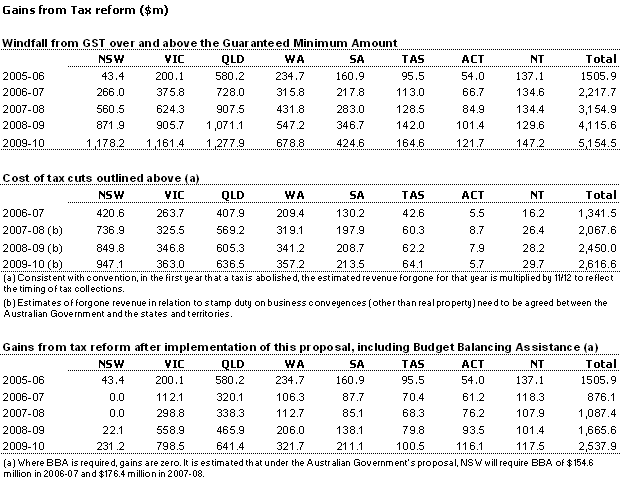Over five years from 2005-06 anticipated GST revenue to the States and Territories under the Intergovernmental Agreement on the Reform of Commonwealth-State Financial Relations (the IGA), is projected to amount to around $207 billion. The windfall over the guaranteed amount is projected to amount to around $16 billion.
Over the years commencing 1 July 2006, the Australian Government proposes the further elimination of $8.8 billion of indirect taxes under the IGA, leaving a continuing GST windfall of around $7.5 billion to the States.
The proposal involves the abolition of the following indirect state taxes on 1July2006: stamp duty on non-quotable marketable securities; stamp duty on leases; stamp duty on mortgages, bonds, debentures and other loan securities; stamp duty on credit arrangements, instalment purchase arrangements and rental arrangements; and stamp duty on cheques, bills of exchange and promissory notes.
Further, stamp duty on business conveyances other than real property would be abolished on 1July2007. This would include the components of business conveyances (such as goodwill, supply rights of a business and intellectual property) listed at ClauseA3(ii) of the original IGA, signed by all States and Territories in April1999.
This leaves stamp duty on business conveyances of real property as the only remaining tax nominated in the IGA. The Australian Government proposes that this tax cease to apply by a date to be determined by the Ministerial Council on the basis that no State or Territory will be worse off in any year.
To ensure no financial disadvantage for any State or Territory, the Australian Government is proposing to extend the transitional period beyond 30June2006 to 30 June 2008, so that any State or Territory which has a shortfall between its GST revenue provision and its Guaranteed Minimum Amount after the implementation of the Australian Government’s proposal would be compensated through BBA. It is estimated that this would result in the Australian Government providing over $330million in BBA in 2006-07 and 2007-08. The extension of the transitional period and the significant windfall gains that are estimated to be received from this proposal make it affordable for all States and Territories.
The full proposal is set out in the Attachment. It provides an opportunity to abolish $8.8 billion of inefficient stamp duties for the benefit of Australian families and businesses over four years commencing on 1 July 2006.
The States asked for 4 to 6 weeks to consider putting an alternative proposal on timing and sequencing the elimination of these state taxes.
23 March 2005
CANBERRA
AUSTRALIAN GOVERNMENT PROPOSAL
- The following State taxes listed in the Intergovernmental Agreement are abolished on 1July2006:
- Stamp duty on non-quotable marketable securities;
- Stamp duty on leases;
- Stamp duty on mortgages, bonds, debentures and other loan securities;
- Stamp duty on credit arrangements, instalment purchase arrangements and rental arrangements; and
- Stamp duty on cheques, bills of exchange and promissory notes.
- Further, stamp duty on business conveyances other than real property is abolished on 1July2007. This would include the components of business conveyances (such as goodwill, supply rights of a business and intellectual property) listed at ClauseA3(ii) of the original Intergovernmental Agreement, signed by all States and territories in April1999.
- Stamp duty on business conveyances of real property will cease to apply by a date to be determined by the Ministerial Council on the basis that no State or Territory will be worse off in any year. This could be reviewed at future Ministerial Councils.
- The tables below show the estimated impact of the proposal. Estimates in these tables have been produced using a methodology consistent with that used by the Australian Government Treasury in the report circulated to the Ministerial Council.

